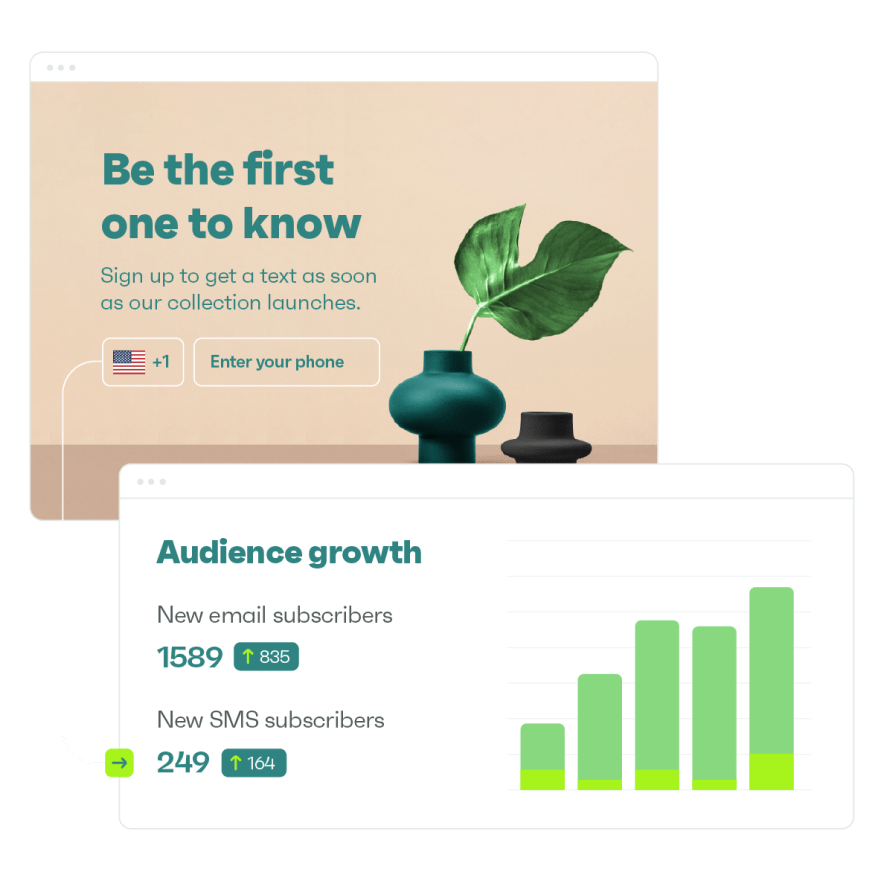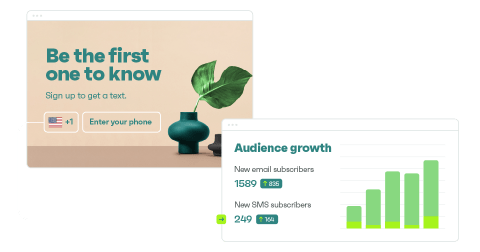Drive sales on autopilot with ecommerce-focused features
See FeaturesPost-purchase messaging for first-time customers
Once you have a first-time buyer as a customer, you should strive to upgrade them to a repeat customer.
By reaching out to them with relevant promotions, important information about their purchases, and addressing them through a variety of different channels, you can garner brand loyalty and create a customer for life.
It’s always worth considering how to use post-purchase emails in your email automation process. Our ecommerce statistics have shown how effective one post-purchase email can be — the feedback request — with a 1.16% sent-to-conversion rate, which equals a 1,000%+ lift over regular email campaigns:
What is post-purchase messaging?
‘Post-purchase’ refers to the final stage of the customer decision process. Some might think the final stage is actually making the purchase, but it’s important to think of the customer journey as a cycle in lieu of a linear process, with post-purchase being the last stage of one purchase and the beginning of the next.
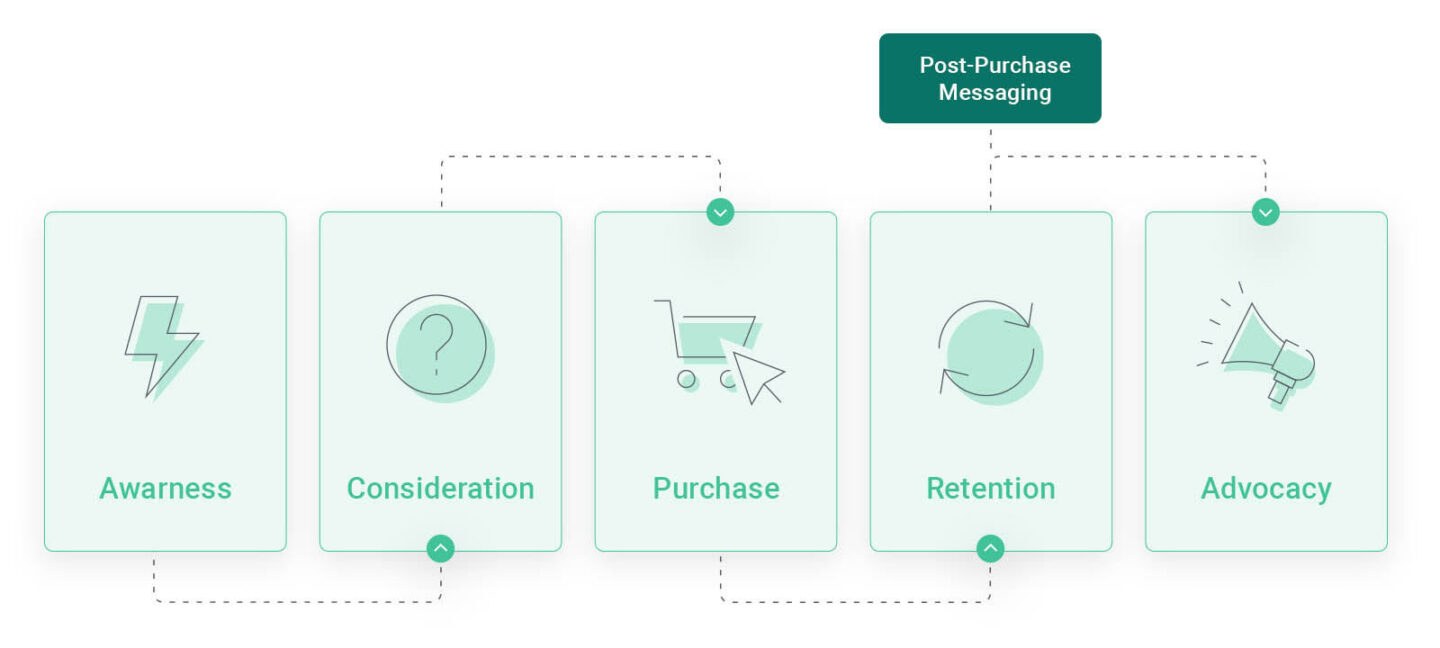
Why? Because even if your customer has made a purchase, they can still return it and ask for a refund. This post-purchase behavior considers whether the customer is satisfied or dissatisfied with the purchase.
This can occur at any time after the purchase has been made, including immediately after receiving an order confirmation and after receiving the product itself.
This post-purchase behavior can occur because:
- The customer has decided they no longer want or need the product.
- The customer feels that the product is different from what they had envisioned.
- The customer isn’t satisfied by the quality of the product.
- The customer has found the same product elsewhere for a better price.
Ensuring your customers are satisfied within the post-purchase process is just one customer retention strategy you can utilize. Ensuring satisfaction throughout the post-purchase process makes it much more likely that you’ll see repeat buyers and returning customers time and time again.
One of the best ways to make the process smoother for your customers is to utilize post-purchase messaging.
Post-purchase messaging can really make or break an experience with a first-time buyer. After all, a new customer is testing the waters with you by making a first purchase. You can have all the positive reviews in the world, but without a positive first impression, that won’t mean much.
If you get it right with their first successful purchase, you’ll have begun to build up trust with them. Post-purchase communication helps to maintain this—they’ll know that you haven’t just taken their money and run with it.
However, as you decide to engage in post-purchase messaging, it’s worth remembering that as effective as emails are, they’re not the only method of messaging you should make use of.
What different forms of post-purchase messaging should a business use?
For years, people have been spending increasing amounts of time on their mobile devices. This makes the likes of instant messaging and SMS (short message service) all the more effective for post-purchase messaging, as well as marketing in general.
Studies show that using other forms of commercial messages can lead to as much, if not more engagement than traditionally sticking to emails. Research has found that 32% of emails are read, while alternatives like WhatsApp reach 31% and SMS/text messages reach 42%.
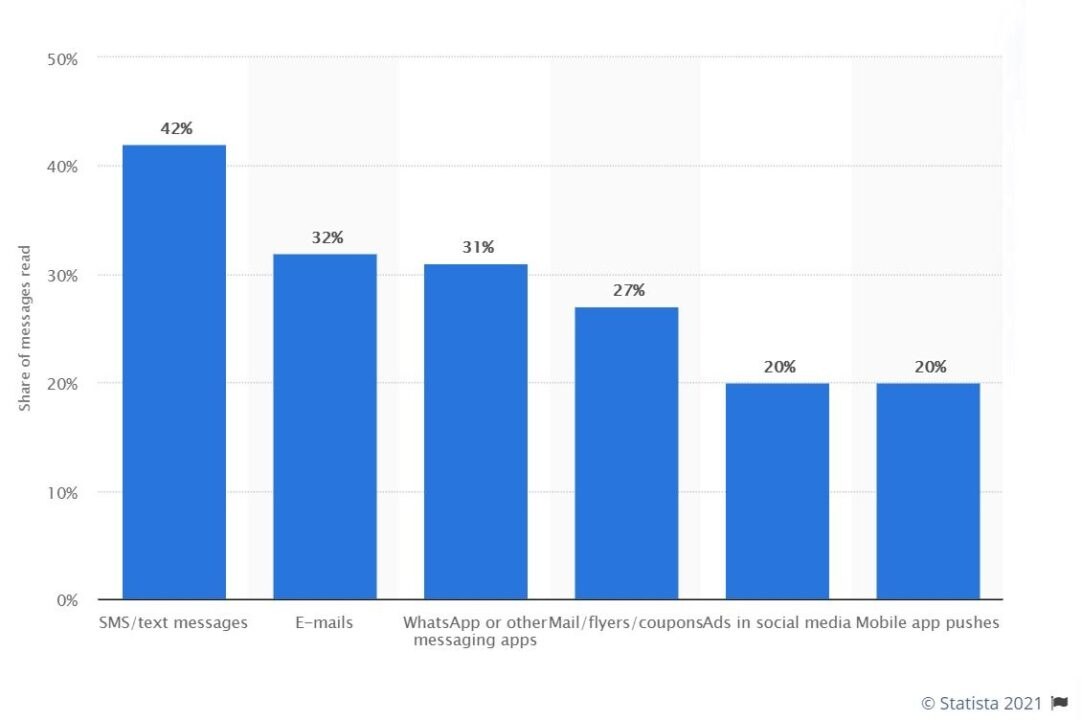
Thanks to this, post-purchase communication plays a large role in a returning customer's campaign, especially when making use of alternative messaging methods. When combined with emails, a business should consider using different channels for post-purchase messaging.
SMS
Quick and cost-effective, SMS serves as a powerful marketing tool, yet is often overlooked. However, statistics show that customers will be more likely to engage in SMS purchasing.
Right off the bat, studies show that customers will both check and interact with SMS quickly and often. For example, our ecommerce reports found conversion rates for SMS increased by 102% between 2019 and 2020.
Understanding how to use SMS marketing effectively is helpful on its own, especially as it can be used for a variety of different purposes. The swift method of delivery and the succinct nature of SMS marketing lends itself well to welcome messages, order confirmations, and cart abandonment notifications.
By using SMS, you can even be creative with your post-purchase messaging. For example, SMS loyalty programs, or SMS campaigns, can be launched by offering SMS updates and exclusive offers at checkout with a small input box for your customers’ phone numbers. You can maintain contact with loyal customers, making them perfect for birthday messages and special time-sensitive offers.
Instant messaging
Not unlike SMS, instant messaging (or IM) is another form of direct messaging which can be tied to a social platform, such as Facebook Messenger, WhatsApp, and Snapchat. These instant messaging platforms are home to a gargantuan reach, with WhatsApp counting 2 billion active users per month, and Facebook Messenger another 1.3 billion.
Some of these platforms, such as Facebook, are often connected to marketplaces. If your ecommerce store is operating on Facebook’s marketplace, it only makes sense to also use their instant messaging to create a better customer experience.
For example, if a customer makes a purchase with a store that’s connected to Facebook, Messenger can handle the post-purchase messaging combined with an email follow-up asking for a review or feedback.
Push notifications
Somewhat of a combination of SMS and IM, push notifications are pop-up messages that can show your customers almost any marketing message. Push notification examples can include time-sensitive offers, cart abandonment reminders, and even stock changes.
It’s worth noting that push notifications don’t solely refer to those that appear on a device when using an app. They can also refer to pop-ups on websites, which can reach your customer no matter what site they’re browsing.
Push notifications are becoming more and more common as customers engage with websites over different devices. From mobile devices to desktop computers, push notifications can provide a lot of value for merchants. For example, Omnisend’s Ecommerce Statistics Report found that push notifications earned a 52.8% view rate plus an impressive 28.1% conversion rate.
Some of the greatest strengths of push notifications come with the way you can specifically cater marketing messages to your direct audience. For example, a customer might receive a push notification with a special discount on their next purchase if they leave a review on their recent purchase. You can use marketing automation to send this push notification in a post-purchase workflow.
By making good use of these different forms of messaging, stores can reach out to audiences with a wide variety of post-purchase communications. By doing so, it becomes easier to determine which type of messaging customers engage with the most.
3 examples of first-time post-purchase email messages
There are several post-purchase emails you would be wise to remember. They are just as important as using effective welcome emails at the beginning of the purchase process. These post-purchase messages include essential messages that reaffirm customer trust and help transform those first-time buyers into repeat customers.
Confirmation email

The confirmation email is the essential message to send as soon as possible after a customer makes a purchase. This eases their mind and gives them something to refer to regarding their purchase.
The confirmation email should contain essential information, such as their order number and a billing summary. The confirmation email also provides excellent examples to improve or enrich the post-purchase process, such as order tracking details and recommended products, based on personalized content.
Thank you & feedback emails
‘Thank you for your purchase’ emails help your customers see your brand as more of a friendly store with passionate people, rather than a faceless website. As effective as this can be, it’s worth remembering that it’s best served only once after a first-time purchase, though there are ways to make the most of that sole ‘thank you’ send.
Have a loyalty system? Tell your customers about it. Want to suggest some upcoming events or product releases? The thank-you email serves this message well into an email campaign. Looking for some feedback? This email isn’t a bad time to ask.
Post-purchase email campaigns are more likely to be successful if the emails work well together. While these messages are often considered separate emails, yet there’s no reason why you can’t combine them into one. For example, not only will a heartfelt thank-you note keep your brand and store fresh in their memory, it also serves as a prime opportunity for feedback.

Naturally, the timing of this email can determine its purpose. You can opt to send it either before the product is delivered or afterwards.
Sending a thank-you message with a feedback request before the product arrives will be more geared towards maintaining a positive image, as well as requested feedback about the customer experience itself.
On the other hand, sending this message after the customer has received the product can serve as a nudge to return to the store as a repeat customer, as well as feedback on the product they purchased.
Relevant promotions

Many businesses will want to continue promotional correspondence with first-time buyers. However, bombarding a potential repeat customer with promotional emails isn’t as likely to yield positive results—unless they’re targeted and relevant.
These promotional messages vary from store to store, depending on what products are sold, yet there are two main types of post-purchase promotional messages.
- Recommended products: Otherwise known as ‘cross-selling’. As aforementioned, these messages feature personalized content that creates recommended products based on previous purchases. By offering add-on style items or even similar products that other customers have frequently bought with the previously purchased products, you’ll provide a more focused, personal recommendation to the customer.
- Replenishing products: Stores that sell products with a short lifecycle can benefit from reminding customers to replenish them. For example, a drink website, or a grooming/beauty product website might have a shorter lifecycle and need replenishment more often. When selling products that are intended to be used, you can time post-purchase messages that remind customers that they can restock from your store.
Whichever message your store sends, you can increase the likelihood of a first-time buyer becoming a repeat buyer by ‘sweetening the deal’. As effective as these messages can be in terms of timing or relevance, sometimes it takes something special to entice them into buying from you again, such as repeat customer discounts or offering free gifts.
4 examples of first-time customer post-purchase messages using different channels
Just like with emails, you can use different channels for post-purchase messaging. For example, one particularly good use of SMS post-purchase messaging is utilizing automated text messages.
Due to the aforementioned shorter and swifter nature of these channels being written and sent, merchants can get creative with how they utilize them post-purchase.
‘Breaking news’

Whether it’s literal breaking news or just a brand-new offer, using short, straight-to-the-point messaging can be much more attention grabbing than sending out emails. By using any alternative channel, whether it’s SMS, instant messaging, or push notifications, you can essentially make the subject line of the email the entire message.
This bite-sized promotion can be used to tantalize the customer into visiting your website, or it can provide all the information they might need to make another purchase right there and then. For example, after making a purchase, sending a text message with an offer for free postage or a time-sensitive discount code.
Instructions and tips
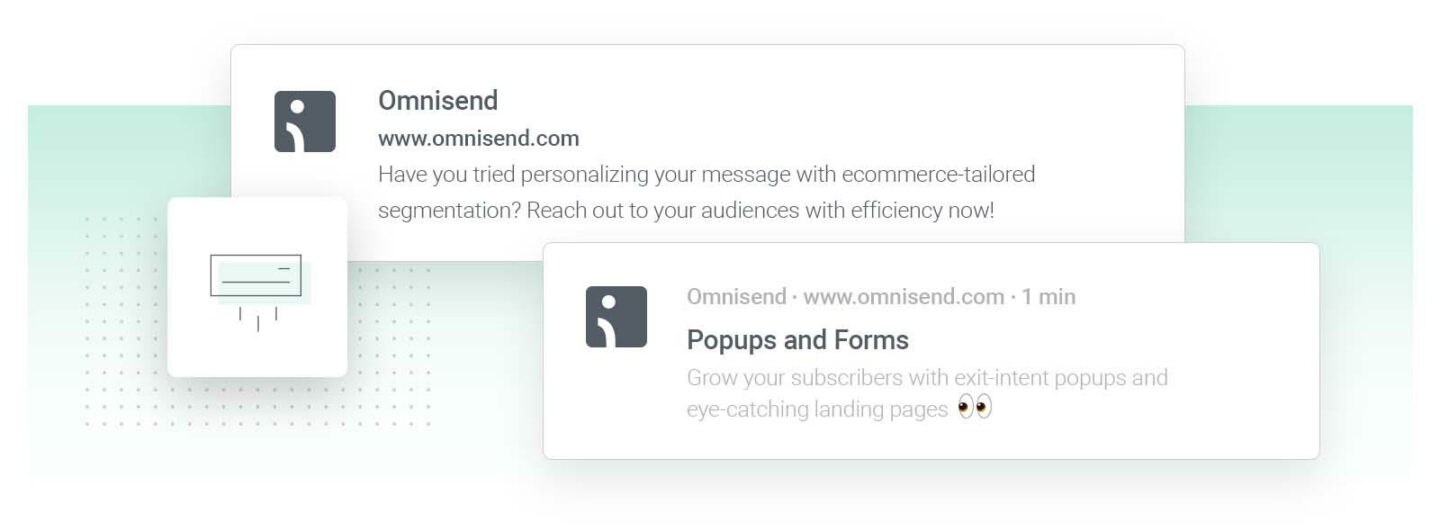
Not unlike a follow-up welcome email, sending order specific instructions and tips can show a customer that you care about their order and their experience with your store. It can be used to cross-sell other products, but most importantly, providing supporting materials for an order can ensure that your customer has everything that you think they’ll need.
For example, a customer orders some flat pack furniture. The building instructions will arrive with the product, but sending them a digital version gives them a back-up and helps them prepare for when they build the furniture. From a strictly business perspective, this also helps your store, as it makes it less likely that the customer will call up or get in touch themselves, asking for the information.
It saves both you and the customer time, making it a win-win. By sending a short message, perhaps with a link to the specific instructions or some general tips that apply to all of your products, you can ensure your first-time buyer knows that you know what you’re talking about. With this expertise established by such specialized post-purchase messaging, you’ll make it all the more likely that your customers will keep coming back to you for more.
Succinct feedback

While you can request feedback or referrals from emails, instant messaging and SMS often lend themselves well to more quick-fire feedback.
While an email can present a customer with several options and a form to fill out, requesting customers to give a simple rating can be much easier and thus makes it more likely that they’ll provide it. For example, as opposed to a form that might take a minute to fill out, allowing a customer to reply to a text with a score out of 10 is instant.
By asking the right questions, you can get quick, measurable answers much more successfully than traditional feedback forms. For example, asking the customer how easy it was to use your website or if they’d found everything they needed.
Live updates
Particularly useful with instant messages, following up an order confirmation with an option to immediately check on the order with live updates may be more engaging than simply having the information waiting for them in an email.
Having the chat function on Facebook Messenger with live chat or a link to delivery tracking can grant a customer peace of mind and show that you’re willing to be transparent with their order status from the get-go. Alternatively, using push notifications on apps can make live updates all the more accurate—and even exciting.
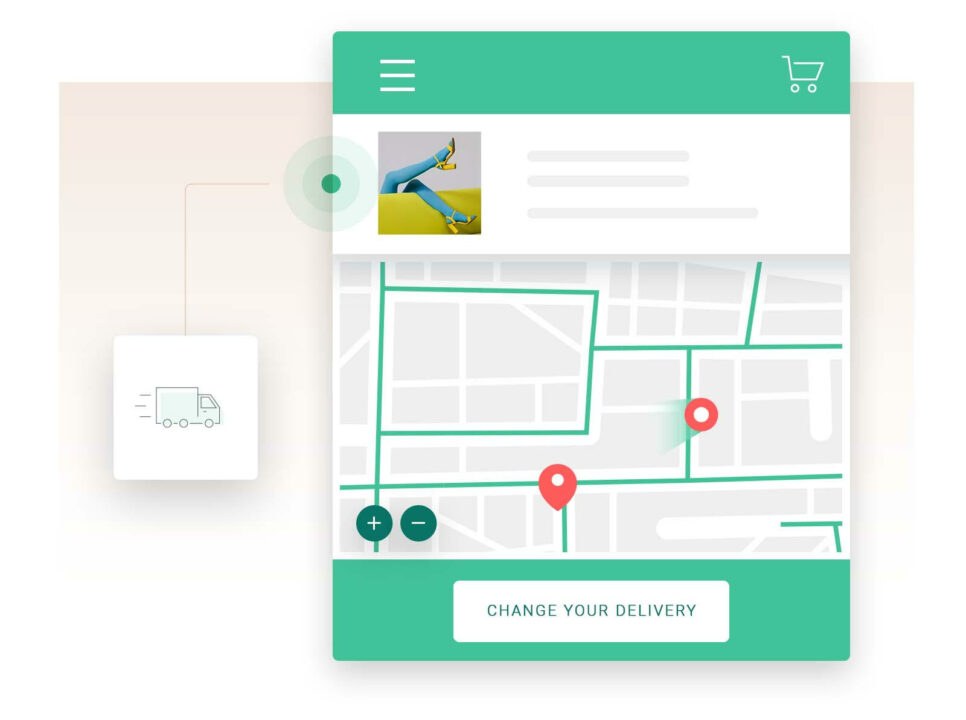
A prime example of this is with Amazon, as their ability to track couriers can pinpoint exactly where a customer’s order is on the delivery route. Appearing as a dot on the map that customers can track, Amazon’s order tracking capabilities even reveal how many stops are in-between the customer and their order, making it much easier to plan for the order arrival.
Wrap up
Every business should strive to convert first-time buyers into repeat buyers. With a healthy combination of good value, great customer service, and alluring products, any good business can succeed—but it’s with post-purchase messaging that a business can become great.
All the hard work you put into attracting new customers and getting them successfully through the checkout can be wasted without proper post-purchase measures. Worse yet, it can be completely undone, resulting in a lack of customer faith and losing sales due to refunds. Without properly keeping your first-time buyers in the loop straight away, you can’t hope to engage with them in the future.
Knowing how to handle this post-purchase communication is often key in transforming first-time buyers into loyal, returning customers. Doing so can be tricky, but with the right tools at your disposal, it’s much easier to pull off.
Enter Omnisend, with features like our automated messaging, our easy-to-use segmentation, multi-channel messaging capabilities, and much, much more. Get in touch today, start your free trial, and see how you can keep your customers coming back time and time again.
quick links
related features
No fluff, no spam, no corporate filler. Just a friendly letter, twice a month.
